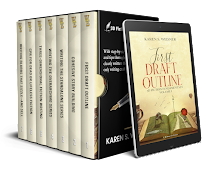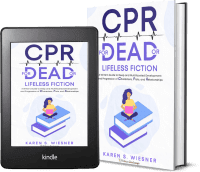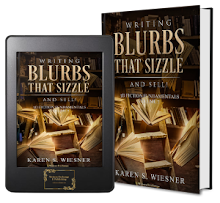Oldies But Goodies
{Put This One on Your TBR List}
Book Review: Warriors
Anthology
Edited by George R. R. Martin and Gardner Dozois
by Karen S. Wiesner

This post contains my 154 review on the Alien Romances Blog!
Warriors, published in 2010, is another cross-genre anthology George R. R. Martin and Gardner Dozois edited and assembled together. As before, this collection with 20 shorts (two of them novellas) was originally published in one large volume. Later, the stories were separated into three paperbacks, and all include Martin's introductory article titled "Stories from the Spinner Rack", which I very much enjoyed reading for its shared nostalgia (though I did wonder if the author actually tried to read a few romances or nurses novels before deciding he'd "never did get into" them). All the authors are big names, award-winning and undeniably gifted, and Warriors won the 2011 Locus Award for Best Anthology.
While I love cross-genre fiction, there were far too many war stories in this one, which probably makes you laugh as much as it does me at this point. For the most part, I picked up this anthology for one story--the George R. R. Martin Dunk and Egg installment (the third in his A Knight of the Seven Kingdoms series).
I guess the word "warrior" has a positive, noble context in my mind. Most of the "warriors" in this anthology, however, weren't necessarily good people in my estimation. I'd call them "rogues" (or something similar) instead. I prefer to believe the best of warriors, and, in my way of thinking, warriors tend to be ordinary joes or janes who step up and become heroes in a crisis, even if they never wanted to be that in the first or last place.
Truthfully I was hoping there would be more fantasy, paranormal, and science fiction selections, or that those types of stories would have something more compelling than run-of-the-mill soldiers who follow orders without actually thinking for themselves, or who fight for a good cause and not simply for whatever the agenda on tap is. A few of the stories stood out in this collection--the ones I'll review here--but, with the exception of The Mystery Knight and The Scroll, even those weren't really what I was looking for. I also feel compelled to inject that one story in particular (that I'm choosing not to name here) was so disturbing, I felt dirty after I read it and I'd give anything to just blot it from my mind for the rest of time. Make of that what you will. Another was written in a way that frustrated me and put me off the story instantly. I don't know if I would have liked it if it'd been written differently or by someone else altogether. Again, since it's a subjective opinion, I won't name that particular story either. I was also sad that I didn't like one of the stories by a popular author I've been reading much more of lately and was looking forward to.
Though similar to other Martin/Dozois anthologies, in that each story in this collection was preceded by a fairly in-depth author biography, the introductory blurbs included for each were so slim, they were all but worthless. It's difficult for me to enjoy something that I don't get an adequate summary for in advance of reading. Probably another "me" thing on that count. I was initially pretty unhappy about the lack of illuminating blurbs until after I read the stories. Then I wondered how to describe them myself. So many defied summary!
Below you'll find the stories I'm covering in this review listed in the order they appear in the original publication in one volume. Technically, they came in 1st, 9th, 12th, 13th, 17th, 18th, 19th, and 20th. For those of you following my anthology reviews, if I'd edited and assembled this collection, I would have started with "The Scroll", ended with The Mystery Knight, and placed the rest of them in this order: Story #4, 7, 10, 12, 14, 16, and 18 instead, with the rest of the stories around them.
1) "The King of Norway" by Cecelia Holland: Bloodthirsty Vikings, complete with violence and vows, about sums up this story. While I'm sorry to say I found it predictable, especially as the make-or-break-it first included in the collection, I did like the line "All dreams are true somehow". I spent a lot of time considering that line apart from the story, if nothing else.
2)
"Seven
Years From Home" by Naomi Novik: This was an interesting sci-fi tale about
a researcher's role in a manufactured war. I was drawn in by the theme of time
not healing some wounds and about how war, "politics and the great
concerns of the universe" leave one content to withdraw into a place where
peace and simplicity are the rule, not the exception, as it is in reality's
ever-present state of violence.
3)
"Out
of the Dark" by David Weber: Compelling.
Literally (and I mean that), humanity's only hope for survival when the Earth
is invaded by canine-like aliens is the very last being one would think of in
terms of providing help to mankind.
All in all, kind of an insane story that makes me laugh in shock each time I
think of it now.
4)
"The
Girls From Avengers" by Carrie
Vaughn: Set in 1943, a woman in WASP (Women Airforce Service Pilots)
investigates the death of her friend. While I might have liked this if the
subject matter and themes were more interesting to me, I will say that this
story did fit the brief of fascinating, worthwhile warriors, the way most of
these tales didn't (in my opinion anyway).
5)
"My
Name is Legion" by David Morell: Set in 1941, members of the French
Foreign Legion do their duty, even if it means fighting each other. While the
story was generally enjoyable, I felt like I was missing something all the time
I was reading. I just didn't get it, which may be more of a commentary on my
dislike of war and stories containing that theme than anything actually wrong
with the piece.
6)
"Defenders
of the Frontier" by Robert
Silverberg: For two decades, the troops manning a fort that was once teaming
with soldiers have done their duty to their realm so completely, they've wiped
out every last enemy. There are only 11 defenders left, and they've had no
contact with the Empire in long enough for them to wonder if they've been
forgotten. I read this in a state of horror from start to finish. These men
struck me as the worst kind of monsters--the kind that doesn't even realize what
they've become by blindly following orders. After submitting without question
for so long, someone and something snaps. It has to. Is all shred of humanity
lost at that point? The story tries to answer that question after a fashion by
the way the survivors react, but I suspect that my answer to the same question
would be on the opposite extreme.
7)
"The
Scroll" by David Ball: A French
engineer and his fellow slaves under a new regime are mere pawns in a diabolical
game in which the madman in charge of building a new city from the rubble
follows the whims of an ancient scroll said to prophesize (and predict) what
the engineer will do next. Wow, was this yet another horrifying refrain! The
engineer trapped in this sad, sordid drama would do anything to stop playing
the role he's been cast into. But it seems like everything he says and does,
everything he doesn't say and doesn't do leads to one thing and one
thing alone: Death. There's no escape. It reminded me a lot of the videogame Fable II, in which the hero is forced to
go to the Spire, where the cold, calculating, nutso Commandant tries to teach
submission to all the slaves. Devoid of choice or freedom, blindly following
some random edict, leaves nothing but no-win situations. This was my second
favorite tale in the collection, mostly because it held me so spellbound while
I read it.
8) The Mystery Knight (Book 3: A Knight of the Seven Kingdoms) by George R. R. Martin: This was hands-down my favorite included in the anthology. I reviewed it back on March 14, 2025 with the two previous stories in its series.
Warriors had a theme that wasn't really geared toward someone like
me, who dislikes war in nearly every context. Those who are fans of war stories
and not-necessarily noble warriors will probably enjoy this anthology much more
than I did.
Karen Wiesner is an award-winning,
multi-genre author of over 150 titles and 16 series.
Visit her website here: https://karenwiesner.weebly.com/
and https://karenwiesner.weebly.com/karens-quill-blog
Find out more about her books and see her art here: http://www.facebook.com/KarenWiesnerAuthor
Visit her publisher here: https://www.writers-exchange.com/Karen-Wiesner/










































